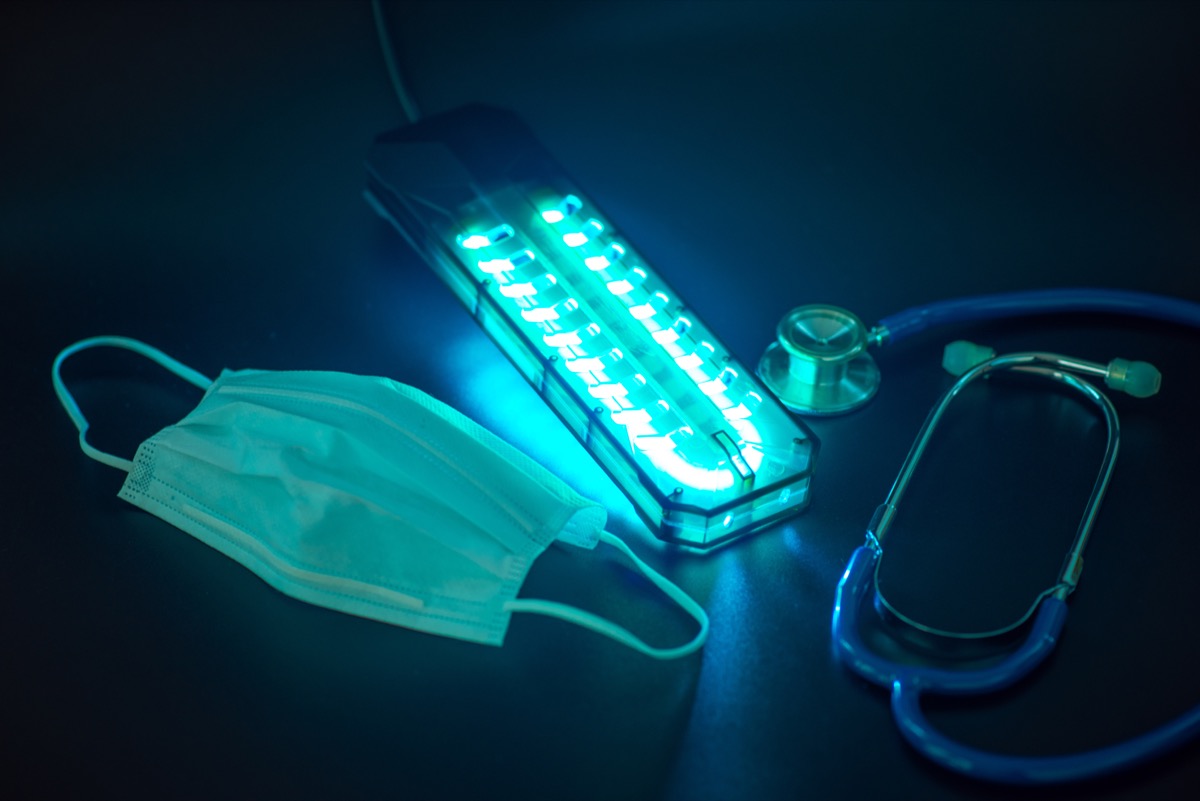UV light is effective in that it damages the DNA or RNA of viruses, Donald Schaffner, PhD, extension specialist in food science and a professor at Rutgers University, said in an interview with Today. “If you damage the nucleic acid of the virus enough, it cannot infect,” he explained. But since humans are made up of genetic material, too, UV light of the intensity needed to kill viruses can cause severe skin burns, skin cancer, and eye damage, according to the International Ultraviolet Association. That’s why they issued the following warning in April: “There are no protocols to advise or to permit the safe use of UV light directly on the human body at wavelengths and exposures proven to efficiently kill viruses such as SARS-CoV0-2.” But what you may not know is that there’s no guarantee that the UV wands and lamps you bought for your home work, according to Jacob Scott, MD, a research physician in the Department of Translational Hematology and Oncology Research at the Cleveland Clinic. “UVC does kill the virus, period, but the issue is you have to get enough dose,” Scott told Live Science. “Particularly, for N95 masks, which are porous, it takes a pretty big dose” to eliminate SARS-CoV-2. How big of a dose exactly? 254 nanometers, according to Scott. RELATED: For more up-to-date information, sign up for our daily newsletter. UVC, one of three common types of UV light produced by sunlight, covers a wavelength spectrum from 200 to 270 nanometers. UVA (320 to 400 nanometers) and UVB (280 to 320 nanometers) cause sunburns and premature skin aging and are associated with the development of skin cancer. UVC’s midrange, between 250 and 254, has been proven to kill bacteria, viruses, and some protozoan parasites. UVC-emitting robots are used to disinfect hospital floors, banks use UVC light to disinfect money, and in New York City, subways are being disinfected by machines emitting the UV light. UVC at a wavelength of 254 nanometers has been shown to inactivate H1N1 influenza and other coronaviruses. And a new study by researchers at Henry Ford Health System in Detroit and the University of Michigan, which has not yet been peer-reviewed, found that UV-C 254 also eliminates SARS-CoV-2, the virus that causes COVID-19. In addition to the lower dosage of at-home UV light devices, another reason why it’s difficult to sanitize phones using UV light is that the buttons and crevices offer places for the virus to hide and avoid getting hit by the rays. Hospitals, by contrast, have the equipment and the expertise to determine the right dosage of UV light needed to kill pathogens. That kind of quality control is impossible to duplicate at home. So, at-home UV devices may give people a false sense of assurance that SARS-CoV-2 has been destroyed when it hasn’t. “Having something you think is clean, but it’s not, is worse than something that you know is dirty” because it affects your behavior toward the object, Scott told Live Science. While coronavirus-killing personal UVC lights that are both safe and effective may be a long way off, scientists are making strides toward developing industrial-sized systems using a UV light in the 207-222 nanometer wavelength range that is not damaging to human skin. Called “far-UVC,” these rays can inactivate airborne aerosolized viruses, which are microscopic, but cannot penetrate the larger outer layers of human skin or eyes, doing damage to deeper living cells.ae0fcc31ae342fd3a1346ebb1f342fcb A July study from researchers at Columbia University Irving Medical Center found that 99.9 percent of seasonal coronaviruses floating in airborne droplets were killed when exposed to this particular wavelength of ultraviolet light that is safe to use around humans. “Based on our results, continuous airborne disinfection with far-UVC light at the current regulatory limit could greatly reduce the level of airborne virus in indoor environments occupied by people,” the study’s lead author David Brenner, PhD, director of the Center for Radiological Research at Columbia University Irving Medical Center, said in a statement. A separate ongoing study at Columbia is testing the efficacy of far-UVC rays on airborne SARS-Cov-2 specifically, with preliminary success. “Far-UVC light doesn’t really discriminate between coronavirus types, so we expected that it would kill SARS-CoV-2 in just the same way,” Brenner said. “Since SARS-CoV-2 is largely spread via droplets and aerosols that are coughed or sneezed into the air, it’s important to have a tool that can safely inactivate the virus while it’s in the air, particularly while people are around.” Brenner believes far-UVC light eventually could be used in gyms, restaurants, theaters, schools, planes, buses, or anywhere people gather, in combination with other safety measures, like wearing face masks and hand-washing, to limit transmission of viruses like the one that causes COVID-19. To learn more about COVID-19, check out 25 Coronavirus Myths You Need to Stop Believing, According to Doctors.

